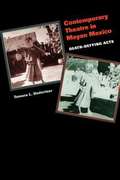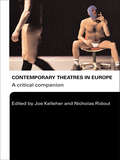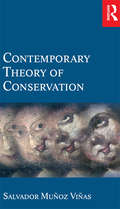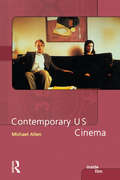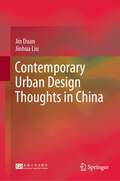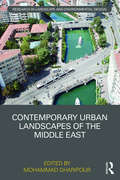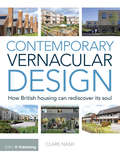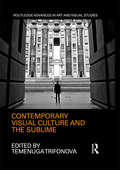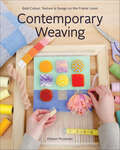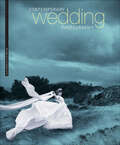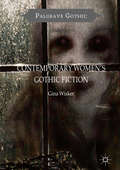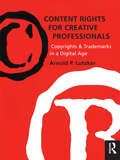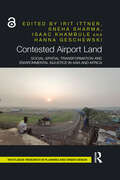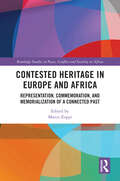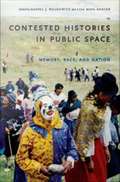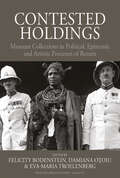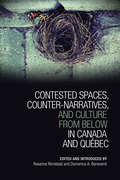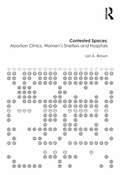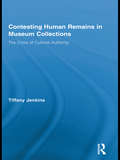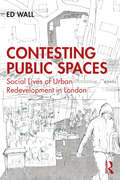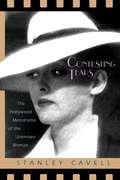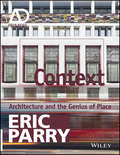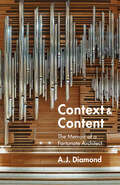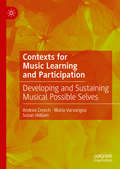- Table View
- List View
Contemporary Theatre in Mayan Mexico: Death-Defying Acts
by Tamara L. UnderinerFrom the dramatization of local legends to the staging of plays by Shakespeare and other canonical playwrights to the exploration of contemporary sociopolitical problems and their effects on women and children, Mayan theatre is a flourishing cultural institution in southern Mexico. Part of a larger movement to define Mayan self-identity and reclaim a Mayan cultural heritage, theatre in Mayan languages has both reflected on and contributed to a growing awareness of Mayans as contemporary cultural and political players in Mexico and on the world's stage. In this book, Tamara Underiner draws on fieldwork with theatre groups in Chiapas, Tabasco, and Yucatán to observe the Maya peoples in the process of defining themselves through theatrical performance. She looks at the activities of four theatre groups or networks, focusing on their operating strategies and on close analyses of selected dramatic texts. She shows that while each group works under the rubric of Mayan or indigenous theatre, their works are also in constant dialogue, confrontation, and collaboration with the wider, non-Mayan world. Her observations thus reveal not only how theatre is an agent of cultural self-definition and community-building but also how theatre negotiates complex relations among indigenous communities in Mayan Mexico, state governments, and non-Mayan artists and researchers.
Contemporary Theatres in Europe: A Critical Companion
by Nicholas Ridout Joe KelleherThrough specific examples, case studies and essays by specialist writers, academics, and a new generation of theatre researchers, this collection of specially commissioned essays looks at current theatre practices across Europe. From Théatre du Soleil to Socìetas Raffaello Sanzio, the authors reconsider the possibilities of theatre practice, its relation to history and location and its place in Europe at the turn of the twenty-first century. Contemporary Theatres in Europe examines a wide range of topics including: mainstream European theatre experimental performance music theatre theatre for children dance theatre. Tailor-made for students, offering clear examples of different ways of thinking and writing about performance, this is a richly detailed introduction which brings key themes to life for all students of European theatre.
Contemporary Theory of Conservation
by Salvador Munoz-VinasClassical theories of conservation are well known in the heritage community, but in the last two decades thinking has shifted, and classical theory has faced increasing criticism. Contemporary Theory of Conservation brings together current ideas in conservation theory, presenting a structured, coherent analysis of the subject for the first time.This engaging and readable text is split into 3 parts. The first, Fundamentals of conservation, addresses the identity of conservation itself, and problems arising when classical conservation theories are applied. The second part, Questioning classical theories, delves deeper into the criticism of classical ideas such as reversibility. This leads on to the creation of new paradigms such as sustainability, which are covered in the final part of the book, Conservation ethics.
Contemporary US Cinema (Inside Film)
by Michael AllenContemporary U.S. Cinema is a forceful exploration of the tumultuous changes that have dominated the shifting landscape of American film-making over the past three decades. From the explosive release of Easy Rider to the excesses of Heaven's Gate and the comic book figures of Spider-Man, its aim is to examine the economic, social and cultural contexts of mainstream and independent American films. The book divides into nine provocative chapters with material on: the most significant individual film-makers, such as Scorsese, Coppola and Lucas, as well as independent film-makers like Jarmusch and Anders the careers of leading actors of the last thirty years, such as Jack Nicholson, Robert Redford and Julia Roberts, whilst exploring the powerful position of the film star in the modern American film-making process the economics of Contemporary U.S. Cinema with particular reference to the tortuous journey from production, distribution and exhibition of Waterworld and Titanic the artistic influence of foreign film-makers, such as François Truffaut and Jean-Luc Godard, and explores Hollywood's increasing dominance and reliance on the global market genres, sequels and the recent developments in computer-based technologies, using examples from The Godfather I - III, The Matrix, the Star Wars saga and remakes from Shaft to Ocean's Eleven The book is illustrated with stills throughout and includes a bibliography and annotated further reading list.
Contemporary Urban Design Thoughts in China
by Jin Duan Jinhua LiuThis book proposes and systematically discusses four trends of thoughts in contemporary Chinese urban design. As the first book to systematically introduce contemporary Chinese urban design thoughts, this book objectively displays the macroscopic picture of contemporary urban design development of China from the time dimension, sorting out seven historical stages and three disputes. This book is mainly divided into two parts. The first part focuses on the vertical description, taking the major events in the seven historical stages as the context, combing the macro picture of the development of contemporary urban design in China in the last 100 years, and describing the three controversies in this process: contention, subject, and legalization. The second part focuses on horizontal observations, puts forward and systematically discusses the four trends of thought formed in the development of contemporary urban design in China, including “Design of Form,” “Synthesis of Design,” “Control of Design,” and “Design of Rule”. This part discusses their development background, theoretical support, and key concepts in detail and finally conducts critical thinking. The whole book is based on historical events, archives, and papers published in Chinese academic journals. While sorting out, summarizing, and objectively discussing, it also makes a critique of urban design activities and academic thinking in China, which will greatly benefit scholars and readers who are interested in urban design history of contemporary China.
Contemporary Urban Landscapes of the Middle East (Routledge Research in Landscape and Environmental Design)
by Mohammad GharipourThe Middle East is well-known for its historic gardens that have developed over more than two millenniums. The role of urban landscape projects in Middle Eastern cities has grown in prominence, with a gradual shift in emphasis from gardens for the private sphere to an increasingly public function. The contemporary landscape projects, either designed as public plazas or public parks, have played a significant role in transferring the modern Middle Eastern cities to a new era and also in transforming to a newly shaped social culture in which the public has a voice. This book considers what ties these projects to their historical context, and what regional and local elements and concepts have been used in their design.
Contemporary Vernacular Design: How British Housing Can Rediscover its Soul
by Clare NashThis book presents 25 international housing schemes that draw on traditional vernacular principles whilst taking into account modern day materials, methods and financial or energy requirements. The aim is to show how, despite mass housing needs, we can design quality modern schemes that ‘fit’ their surroundings and generate a sense of place, community and regional identity – rather than the poor quality, identikit housing currently seen wherever you are in the UK.
Contemporary Visual Culture and the Sublime (Routledge Advances in Art and Visual Studies)
by Temenuga TrifonovaIn the course of its long and tumultuous history the sublime has alternated between spatial and temporal definitions, from its conceptualization in terms of the grandeur and infinity of Nature (spatial), to its postmodern redefinition as an "event" (temporal), from its conceptualization in terms of our failure to "cognitively map" the decentered global network of capital or the rhizomatic structure of the postmetropolis (spatial), to its neurophenomenological redefinition in terms of the new temporality of presence produced by network/real time (temporal). This volume explores the place of the sublime in contemporary culture and the aesthetic, cultural, and political values coded in it. It offers a map of the contemporary sublime in terms of the limits—cinematic, cognitive, neurophysiological, technological, or environmental—of representation.
Contemporary Weaving: Bold Colour, Texture & Design on the Frame Loom
by Allyson RousseauDive into eye-catching contemporary weaving With renowned artist Allyson Rousseau, contemporary weaving is simple, bold, and colourful. In this book, Allyson explores everything a beginning weaver needs and provides techniques advanced weavers can combine and expand on in their practices. Start by exploring fibres and tools, and then build your own frame loom. Dive into the many weaving techniques that characterize Allyson’s contemporary pieces. Take your home decor to the next level with projects like wall hangings, pillows, and coasters, and make unique brooches and necklaces that stand out in any setting. Bright colours and bold designs made to stand out in the home or as accessories Includes all the information a beginner needs to start weaving, from making a frame loom and choosing fibre, to completing a stunning project Learn to build your own designs using colour theory, grid planning, and palette building
Contemporary Wedding Photography
by Julie Oswin Steve WaltonWedding photography has become about story-telling-capturing the emotions and atmosphere of the day through reportage-style photography. This user-friendly manual reveals the techniques needed to create this contemporary style, for professional photographers looking to update their methods, or for aspiring photographers wanting to break into this lucrative market.Includes all the advice you need, from preparation and planning before the wedding, to digital manipulation of your images and presentation to the couple.Features comprehensive checklists, professional tips, tried-and-tested templates, advice boxes and step-by-step sequences to provide endless inspiration and guarantee successful shooting.Demonstrates the fresh contemporary style preferred by modern couples.
Contemporary Women's Gothic Fiction: Carnival, Hauntings and Vampire Kisses (Palgrave Gothic)
by Gina WiskerThis book revives and revitalises the literary Gothic in the hands of contemporary women writers. It makes a scholarly, lively and convincing case that the Gothic makes horror respectable, and establishes contemporary women’s Gothic fictions in and against traditional Gothic. The book provides new, engaging perspectives on established contemporary women Gothic writers, with a particular focus on Angela Carter, Margaret Atwood and Toni Morrison. It explores how the Gothic is malleable in their hands and is used to demythologise oppressions based on difference in gender and ethnicity. The study presents new Gothic work and new nuances, critiques of dangerous complacency and radical questionings of what is safe and conformist in works as diverse as Twilight (Stephenie Meyer) and A Girl Walks Home Alone (Ana Lily Amirpur), as well as by Anne Rice and Poppy Brite. It also introduces and critically explores postcolonial, vampire and neohistorical Gothic and women’s ghost stories.
Content Rights for Creative Professionals: Copyrights & Trademarks in a Digital Age
by Arnold P. LutzkerContent Rights for Creative Professionals is for professionals and students working in all areas of media (film/video, photography, multimedia, web, graphics, and broadcast) who need to know what the law requires and how they should properly utilize copyrights and trademarks. This book outlines critical concepts and applies them with explanations in real-life applications, including many cases from the author's own practice as well as those of various media professionals. This 256 page text is a practical guide designed to provide its reader with a firm understanding of the principles underlying the ownership and use of content, so that when questions arise, they will be able to make correct, well-informed decisions-whether concerning their personal works, or works of others that a company wishes to copyright or trademark. In addition, the reader will be more capable of exercising sound judgment in structuring employment and contract relationships and of acquiring and/or licensing works, which are at the core of the business of communicating.
Content-Based Image Retrieval: Ideas, Influences, and Current Trends
by Vipin TyagiThe book describes several techniques used to bridge the semantic gap and reflects on recent advancements in content-based image retrieval (CBIR). It presents insights into and the theoretical foundation of various essential concepts related to image searches, together with examples of natural and texture image types. The book discusses key challenges and research topics in the context of image retrieval, and provides descriptions of various image databases used in research studies. The area of image retrieval, and especially content-based image retrieval (CBIR), is a very exciting one, both for research and for commercial applications. The book explains the low-level features that can be extracted from an image (such as color, texture, shape) and several techniques used to successfully bridge the semantic gap in image retrieval, making it a valuable resource for students and researchers interested in the area of CBIR alike.
Contested Airport Land: Social-Spatial Transformation and Environmental Injustice in Asia and Africa (Routledge Research in Planning and Urban Design)
by Sneha Sharma Irit Ittner Isaac Khambule Hanna GeschewskiContested Airport Land draws attention to the accelerating airport development in the Global South. Empirical studies provide nuanced analysis of socioeconomic, administrative, and political dynamics on the land beyond the airport grounds, such as the project area of greenfield development, the airport city, or land resources reserved for future airport expansion.The authors in this book emphasise why airport construction is a politically sensitive issue in low-income and low-middle-income countries, which serve as the last development frontier of the aviation sector. They argue that observed airport development was rather motivated by the perception of airports as engines for national economic growth, while improving air mobility of national populations was not the main driver. Under dominant national development visions, airport-induced dynamics threatened local livelihoods by triggering economies of anticipation, the reconfiguration of land markets, rapid land use changes, a transition from rural to urban livelihoods, the displacement of communities, the perpetuation of human–wildlife conflicts, or inter-ethnic violence. The authors also highlight colonial path dependencies; legal pluralism in land tenure; the hegemonic relations between builders, investors, and the affected residents; as well as strategies of local protest movements.This book is recommended for readers interested in infrastructure-induced conflicts and environmental injustice.Chapter 1, Chapter 6 and Chapter 8 of this book are freely available as a downloadable Open Access PDF at http://www.taylorfrancis.com under a Creative Commons Attribution-ShareAlike (CC-BY-SA) 4.0 license.
Contested Heritage in Europe and Africa: Representation, Commemoration, and Memorialization of a Connected Past (Routledge Studies in the Modern History of Africa)
by Marco ZoppiThis book investigates Euro-African cultural relations, considering their connected histories through material and immaterial forms of representation, commemoration, and memorialization. Recent waves of protest around the world have called for restitution of looted African art, and toppled statues and vandalized monuments which are connected to white suprematism, colonialism, and imperialism. These events have highlighted an urgent need to debate the management and preservation of Europe and Africa’s shared heritage. Drawing on a range of varied, trans-continental case studies, this book considers the key question of whether such monuments should be removed as forms of unacceptable celebration of an evil past, or preserved precisely because of what they recount about that past of oppression and domination. The book encourages readers to consider how diverse and pervasive the notions of shared heritage and common past are, encompassing discussions of statues, exhibitions, graffiti, tapestries, and commemorations. Providing a timely analysis of the developing cultural relations between Africa and Europe, this book will be an important resource for researchers across the fields of global history, heritage studies, memory studies, and international relations.
Contested Histories in Public Space: Memory, Race, and Nation
by Daniel J. Walkowitz Lisa Maya KnauerContested Histories in Public Space brings multiple perspectives to bear on historical narratives presented to the public in museums, monuments, texts, and festivals around the world, from Paris to Kathmandu, from the Mexican state of Oaxaca to the waterfront of Wellington, New Zealand. Paying particular attention to how race and empire are implicated in the creation and display of national narratives, the contributing historians, anthropologists, and other scholars delve into representations of contested histories at such "sites" as a British Library exhibition on the East India Company, a Rio de Janeiro shantytown known as "the cradle of samba," the Ellis Island immigration museum, and high-school history textbooks in Ecuador. Several contributors examine how the experiences of indigenous groups and the imperial past are incorporated into public histories in British Commonwealth nations: in Te Papa, New Zealand's national museum; in the First Peoples' Hall at the Canadian Museum of Civilization; and, more broadly, in late-twentieth-century Australian culture. Still others focus on the role of governments in mediating contested racialized histories: for example, the post-apartheid history of South Africa's Voortrekker Monument, originally designed as a tribute to the Voortrekkers who colonized the country's interior. Among several essays describing how national narratives have been challenged are pieces on a dispute over how to represent Nepali history and identity, on representations of Afrocuban religions in contemporary Cuba, and on the installation in the French Pantheon in Paris of a plaque honoring Louis Delgrs, a leader of Guadeloupean resistance to French colonialism. Contributors. Paul Amar, Paul Ashton, O. Hugo Benavides, Laurent Dubois, Richard Flores, Durba Ghosh, Albert Grundlingh, Paula Hamilton, Lisa Maya Knauer, Charlotte Macdonald, Mark Salber Phillips, Ruth B. Phillips, Deborah Poole, Anne M. Rademacher, Daniel J. Walkowitz
Contested Holdings: Museum Collections in Political, Epistemic and Artistic Processes of Return (Museums and Collections #14)
by Eva-Maria Troelenberg Felicity Bodenstein, Damiana OţoiuGoing beyond strictly legal and property-oriented aspects of the restitution debate, restitution is considered as part of a larger set of processes of return that affect museums and collections, as well as notions of heritage and object status. Covering a range of case studies and a global geography, the authors aim to historicize and bring depth to contemporary debates in relation to both the return of material culture and human remains. Defined as contested holdings, differing museum collections ranging from fine arts to physical anthropology provide connections between the treatment and conceptualization of collections that generally occupy separate realms in the museum world.
Contested Spaces, Counter-narratives, and Culture from Below in Canada and Québec
by Roxanne Rimstead Domenic A. BeneventiThis collection explores strategies of reading space and conflict in Canadian and Québécois literary and cultural performances. How do literary texts and popular cultural performances produce and contest spatial practices? What is the role of the nation, the city, the community, and the individual subject in reproducing space, even during times of global hegemony and neocolonialism? In what ways do marginalized individuals and communities represent, contest, or appropriate spaces through counter-narratives and expressions of culture from below? And how does space itself shape conflict, counter-memory, and culture from below? Focusing on contestation instead of harmony and consensus, Contested Spaces disturbs the idealized space of Canadian multicultural pluralism to carry literary analysis and cultural studies into spaces often undetected and unforeseen; Contested Spaces exposes geographies of exclusion and difference such as flophouses and "slums," shantytowns and urban alleyways, underground spaces and peep shows, inner city urban parks as experienced by minority ethnics, the poor, women, social activists, Indigenous people, and Francophones in Canada. These essays are the product of sustained and high-level collaboration across French and English academic communities in Canada to facilitate theoretical exchange on the topic of space and contestation, to expose geographies of exclusion, and to generate new spaces of hope in the spirit of pioneering work by Henri Lefebvre, Michel Foucault, Michel de Certeau, Doreen Massey, David Harvey, and other more recent theorists of space.
Contested Spaces: Politicizing the Female Body
by Lori A. BrownIn this book, Lori Brown examines the relationship between space, defined physically, legally and legislatively, and how these factors directly impact the spaces of abortion. It analyzes how various political entities shape the physical landscapes of inclusion and exclusion to reproductive healthcare access, and questions what architecture's responsibilities are in respect to this spatial conflict. Employing writing, drawing and mapping methodologies, this interdisciplinary project explores restrictions and legislatures which directly influence abortion policy in the US, Mexico and Canada. It questions how these legal rulings produce spatial complexities and why architecture isn't more culturally and spatially engaged with these spaces. In Mexico, where abortion is fully legal only in Mexico City during the first trimester, women must travel vast distances and undergo extreme conditions in order to access the procedure. Conservative state governments continue to make abortion a severely punishable crime. In Canada, there are nowhere near the cultural and religious stigmas to abortion as in the US and Mexico. Completely legal and without restrictions, Canada offers an important contrast to the ongoing abortion issues within the US and Mexico. Researching the spatial implications of such a politicized space, this book expands beyond a study of abortion clinic and includes other spaces such as women's shelters and hospitals that require multiple levels of secured spaces in order to discuss the spatial ramifications of access and security within spaces that are highly personal, private, and sometimes secret or even hidden. In questioning what architecture's responsibility is in these spatial conflicts, the book looks at how what architecture 'does' can be used to reconsider the spaces and security around such contested places, and ultimately suggests what design's potential impact might be. In doing so, it shows how architecture's role might be redefined within social and spatial practices.
Contesting Human Remains in Museum Collections: The Crisis of Cultural Authority (Routledge Research in Museum Studies)
by Tiffany JenkinsSince the late 1970s human remains in museum collections have been subject to claims and controversies, such as demands for repatriation by indigenous groups who suffered under colonization. These requests have been strongly contested by scientists who research the material and consider it unique evidence. This book charts the influences at play on the contestation over human remains and examines the construction of this problem from a cultural perspective. It shows that claims on dead bodies are not confined to once colonized groups. A group of British Pagans, Honouring the Ancient Dead, formed to make claims on skeletons from the British Isles, and ancient human remains, bog bodies and Egyptian mummies, which have not been requested by any group, have become the focus of campaigns initiated by members of the profession, at times removed from display in the name of respect. By drawing on empirical research including extensive interviews with the claims-making groups, ethnographic work, document, media, and policy analysis, Contesting Human Remains in Museum Collections demonstrates that strong internal influences do in fact exist. The only book to examine the construction of contestation over human remains from a sociological perspective, it advances an emerging area of academic research, setting the terms of debate, synthesizing disparate ideas, and making sense of a broader cultural focus on dead bodies in the contemporary period.
Contesting Public Spaces: Social Lives of Urban Redevelopment in London
by Ed WallThis book explores concerns for spatial justice as streets, squares, and neighbourhoods are continuously made and remade through planning processes, political ambitions and everyday activities. By investigating three sites in London that have been the focus of masterplanning, Ed Wall exposes conflicts between planning offices and private developers who direct large urban change and community groups, market traders and residents whose public lives are inseparable from their neighbourhoods being reconfigured. The book uniquely brings sociological approaches to what are often considered architectural concerns, revealing challenges as London's public spaces are designed, regulated and lived. Through in-depth research, Ed Wall identifies how uncertainty caused by large-scale urban strategies, the realisation of visual priorities, and uneven relations between private interests, public organisations and daily lives determine the public realm of global cities. This work is intended for readers interested in how the urban spaces of their cities are continually produced in competing ways—from architecture and urban studies scholars to planners and politicians.
Contesting Tears: The Hollywood Melodrama of the Unknown Woman
by Stanley CavellWhat is marriage? Can a relationship dedicated to equality, friendship, and mutual education flower in an atmosphere of romance? What are the paths between loving another and knowing another? Stanley Cavell identified a genre of classic American films that engaged these questions in his study of comedies of remarriage, Pursuits of Happiness. With Contesting Tears, Cavell demonstrates that a contrasting genre, which he calls "the melodrama of the unknown woman," shares a surprising number and weave of concerns with those comedies. Cavell provides close readings of four melodramas he finds definitive of the genre: Letter from an Unknown Woman, Gaslight, Now Voyager, and Stella Dallas. The women in these melodramas, like the women in the comedies, demand equality, shared education, and transfiguration, exemplifying for Cavell a moral perfectionism he identifies as Emersonian. But unlike the comedies, which portray a quest for a shared existence of expressiveness and joy, the melodramas trace instead the woman's recognition that in this quest she is isolated. Part of the melodrama concerns the various ways the men in the films (and the audiences of the films) interpret and desire to force the woman's consequent inaccessibility. "Film is an interest of mine," Stanley Cavell has written, "or say a love, not separate from my interest in, or love of, philosophy. " In Contesting Tears Cavell once again brilliantly unites his two loves, using detailed and perceptive musings on melodrama to reflect on philosophical problems of skepticism, psychoanalysis, and perfectionism. As he shows, the fascination and intelligence of such great stars as Ingrid Bergman, Bette Davis, and Barbara Stanwyck illuminate, as they are illuminated by, the topics and events of these beloved and enduring films.
Context
by Eric ParryDemonstrates how a building′s setting should inform and inspire rather than constrain architectural design Context–Architecture and the Genius of Place is a highly engaging, informative discussion of context in architectural theory and practice. Eric Parry, one of the UK′s most highly regarded architects whose work has been widely lauded for its innovative response to its setting addresses the contemporary definition of context and its importance for sustainable everyday living and urban design. Looking beyond the formal agenda to explore the fundamentals that give new social and cultural perspective to this vital point of departure for designers, this book turns the urban statistician′s telescopic focus on global trends inside out for a better understanding of the cultural and physical conditions that make archetypes like the Parisian Caf&É, the London High Street, the Baltic City Square, and the Mumbai Market part of the architect′s lexicon. From pavement to landscape, readers will examine how context must be taken into account at every stage in the design process. This book draws on the author′s extensive experience within complex urban settings to show how the existing fabric and social conditions can provide an essential starting point for new design, offering a framework for thinking about design responses and their relationship to cultural origins of place. Discover the importance of orientation Develop a sequential understanding of urban space Hear the dialogue between parts within a whole Differentiate the uses of formal and informal Whereas existing urban settings, particularly historic city centers, are generally regarded as limiting to architectural creativity, this book presents context as grounds for inspiration rather than constraint. When used correctly, these techniques create the feeling that a new building has always been there, simply because it "fits". Context explains the methods behind brilliant architecture, helping designers create buildings that not only belong, but can provide a catalyst to urban life.
Context and Content: The Memoir of a Fortunate Architect
by A.J. DiamondA deeply personal memoir from one of Canada’s most celebrated architects.In this personal account of A.J. Diamond’s life and work, he shares how he came to be the founder of the leading architecture firm Diamond Schmitt, one of Canada’s most successful architecture companies. He also explains his principles of design, which at their core are about making a positive impact in the world, considering the needs of the content, client, and context. Diamond gives insight into his design principles in relation to some of his most notable projects, including the Four Seasons Centre for the Performing Arts in Toronto, la Maison symphonique de Montréal, the Mariinsky II Theatre in Saint Petersburg, and the new city hall in Jerusalem. Diamond also chronicles his family ancestry, his childhood in South Africa, from his birth in his grandfather’s study in the small provincial town of Piet Retief on the borders of Eswatini (Swaziland) and Mozambique, to his university days at the University of Cape Town and Oxford — where he played rugby at the international level, scoring two winning tries for the Oxford Blues against Australia — and the University of Pennsylvania. His memoir traces his immigration to the U.S. and, eventually, Canada as well as his growing architectural practice in Toronto, where he focused on the issues facing his chosen city.
Contexts for Music Learning and Participation: Developing and Sustaining Musical Possible Selves
by Susan Hallam Maria Varvarigou Andrea CreechThis book sets out a contemporary perspective on music education, highlighting complex intersections between informal, non-formal and formal practices and contexts. At a time when the boundaries between music learning and participation are increasingly blurred, this volume is distinctive in challenging a ‘siloed’ approach to understanding the diverse international music education landscape. Instead, the book proposes a multi-layered continuum of practices that can be applied across a range of formal, informal or non-formal concepts to support the development of musical possible selves. It challenges existing conceptions of learning in music education in part by drawing on research in adult learning, but also by considering the contexts in which learning takes place, and the extent to which this learning can be classified as formal, informal or non-formal.
